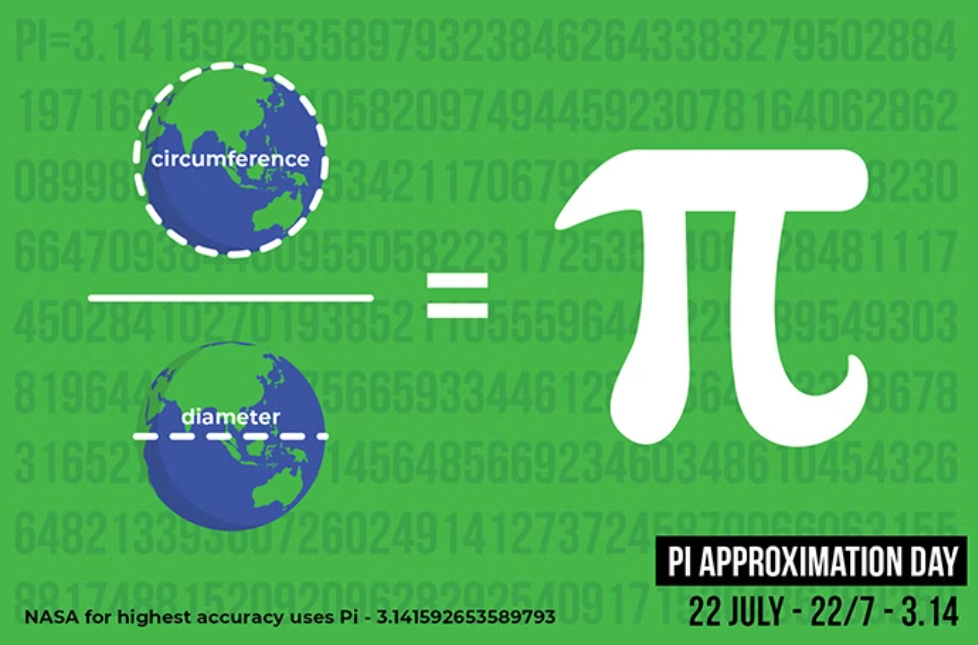Pi (22 7) Approximation Day, celebrated on July 22nd (22 7), is a delightful occasion to explore the intriguing world of Pi (π)—the mathematical constant that represents the ratio of a circle’s circumference to its diameter. While Pi (22 7) Day on March 14th (3/14) is widely recognized, Pi Approximation Day offers its charm by celebrating Pi (22 7), a convenient approximation of Pi.
In this blog, we’ll uncover 7 lesser-known facts about Pi (22 7) and highlight why this day is significant in mathematics.
Table of Contents
Importance of Pi (22 7) in Mathematics
The Ubiquity of Pi
Pi (22 7) is a fundamental mathematical constant appearing in various formulas related to circles and spheres. Its importance extends far beyond geometry, influencing fields such as trigonometry, calculus, and complex analysis. Pi (22 7) is crucial for calculating areas and volumes of circular and spherical shapes, and it plays a key role in many mathematical proofs and equations.
Applications Across Disciplines
Pi’s significance stretches beyond pure mathematics into physics, engineering, statistics, and even art and music. Whether designing mechanical systems or understanding wave properties, Pi’s applications are diverse and essential for scientific and technological progress.
Explanation of Pi (22 7 )as an Approximation of Pi

Why 22/7 is a Good Approximation
The fraction 22/7 approximates Pi closely, yielding a value of approximately 3.142857. This is quite near to Pi’s actual value of about 3.14159, with a relative error of just 0.04%. This makes Pi (22 7) a handy and straightforward approximation for many practical mathematical calculations.
Comparison with Other Approximations
Although Pi (22 7) is a popular approximation, other fractions offer even closer estimates. For instance, the fraction 355/113, used by Chinese mathematician Zu Chongzhi (429-500 AD), gives a value of about 3.1415929, which is incredibly close to Pi. Despite this, 22/7 remains favored for its simplicity and ease of use.
Mathematical Properties and Significance
Pi (22 7) is an irrational number, which means it cannot be represented as a simple fraction or ratio of two whole numbers. It is also a transcendental number, indicating that it is not a root of any non-zero polynomial equation with rational coefficients. These properties make Pi a captivating and complex constant that continues to fascinate mathematicians and scientists.
Fact 1: Historical Origins
History of Pi (22 7) Approximation Day
Pi (22 7) Approximation Day has become a popular occasion to celebrate the significance of Pi in mathematics. The use of the fraction 22/7 dates back to ancient times, notably used by Greek mathematician Archimedes of Syracuse (287-212 BC). Archimedes was among the first to calculate Pi (22 7) with impressive accuracy by using inscribed and circumscribed polygons. The simplicity of 22/7 made it a widely accepted approximation.
Fact 2: Mathematical Significance
Why 22/7 is a Good Approximation
As noted earlier, 22/7 approximates Pi with a value of 3.142857, close to Pi’s true value of 3.14159. With a relative error of just 0.04%, this fraction remains a practical and useful approximation for various calculations.
Comparison with Other Approximations
While 22/7 is convenient, other fractions like 355/113 provide even closer approximations. The fraction 355/113, developed by Zu Chongzhi, approximates Pi (22 7) to a high degree of accuracy. Nonetheless, 22/7 is preferred for its simplicity and ease of application.
Mathematical Properties and Significance
Pi’s status as an irrational and transcendental number highlights its uniqueness in mathematics. Its inability to be expressed as a simple fraction or solve polynomial equations with rational coefficients adds to its allure and complexity.
Fact 3: Cultural Celebrations
How Pi (22 7) Approximation Day is Celebrated Around the World
Math enthusiasts, schools, and educational institutions celebrate Pi Approximation Day with various engaging activities. These events emphasize the importance of Pi and its approximations in mathematics.
Examples of Events and Activities
In schools, teachers often organize Pi-themed lessons and activities to captivate students. Activities might include Pi quizzes, pie-eating contests, and math games involving circle measurements.
Fun Ways to Celebrate with Family and Friends
Pi (22 7) Approximation Day can be both fun and educational. Consider baking a pie (playing on the word “Pi”), hosting a Pi trivia night, or watching math documentaries with family and friends.
Fact 4: Educational Impact
Role of Pi Approximation Day in Education
Pi (22 7) Approximation Day offers a unique opportunity to make learning about Pi enjoyable and interactive. It helps introduce or reinforce Pi-related concepts in a way that engages students.
Activities and Lessons in Schools
Teachers can use Pi Approximation Day for hands-on activities, such as measuring circular objects to calculate Pi. These interactive lessons help students grasp mathematical concepts and develop problem-solving skills.
Importance of Teaching Pi and Its Approximations
Understanding Pi (22 7) is crucial for students’ mathematical growth and problem-solving abilities. Learning about Pi encourages curiosity and a deeper appreciation for math, illustrating its real-world applications.
Fact 5: Interesting Trivia
Fun and Quirky Trivia About Pi (22 7)
Archimedes’ Constant: The fraction 22/7 is sometimes called “Archimedes’ constant” due to its historical use.
Modern Calculations: Pi has been computed to over a trillion digits, yet 22/7 remains a simple and useful approximation.
The symbol for Pi (22 7): The symbol “π” was introduced by Welsh mathematician William Jones in 1706.
Anecdotes and Stories
Archimedes’ method of approximating Pi through polygons is a story of mathematical brilliance. Similarly, Indian mathematician Srinivasa Ramanujan’s series for calculating Pi showcases the depth of mathematical exploration.
Contributions from Notable Mathematicians
Alongside Archimedes and Ramanujan, mathematicians like Zu Chongzhi, John Wallis, and Carl Friedrich Gauss have made significant contributions to the study and calculation of Pi (22 7).
Fact 6: Real-World Applications

Practical Uses of Pi and Its Approximations
Pi (22 7) is essential in various practical fields, including engineering, science, and everyday life. Engineers use Pi to design circular components, while scientists use it to study waves and orbits.
Examples from Engineering, Science, and Everyday Life
Engineering: Pi is used to calculate the area and volume of circles, cylinders, and spheres.
Science: Pi helps understand wave properties, such as sound and light.
Everyday Life: Pi is useful for measuring circular objects like round tables or garden beds.
Importance of Accurate Approximations
Accurate Pi approximations are vital for precise calculations in technology and industry. For example, in computer graphics and manufacturing, accurate Pi values ensure high-quality results.
Fact 7: Pi in Pop Culture
References to Pi (22 7) in Media
Pi has permeated popular culture, appearing in movies, books, and media. Notable examples include:
“Pi”: A film by Darren Aronofsky about a mathematician obsessed with finding patterns in Pi.
“Life of Pi”: A novel by Yann Martel featuring a young boy named Pi who survives a shipwreck.
Popular Culture’s Take on Pi
Pi symbolizes mathematical curiosity and exploration, often featured in-jokes, puzzles, and artistic representations. Pi Day (March 14th) is celebrated with pie-eating contests and recitation competitions.
Influence of Pi Approximation Day on Art and Literature
Pi Approximation Day has inspired artistic and literary works that explore Pi’s beauty and complexity. From paintings and sculptures to poems, Pi continues to captivate creative minds.
Final Thoughts on Pi Approximation Day
Pi (22 7) Approximation Day is more than a celebration; it’s a chance to appreciate the beauty of mathematics, engage in fun activities, and inspire curiosity about Pi.
We hope you’ve enjoyed discovering these fascinating aspects of Pi. We’d love to hear your stories and facts related to Pi Approximation Day. Have you celebrated this day? Share your experiences in the comments below!
Continue your mathematical journey and discover more about Pi and its significance. There’s always a fresh and captivating insight to explore in the world of mathematics!




Thanks for sharing. I read many of your blog posts, cool, your blog is very good.